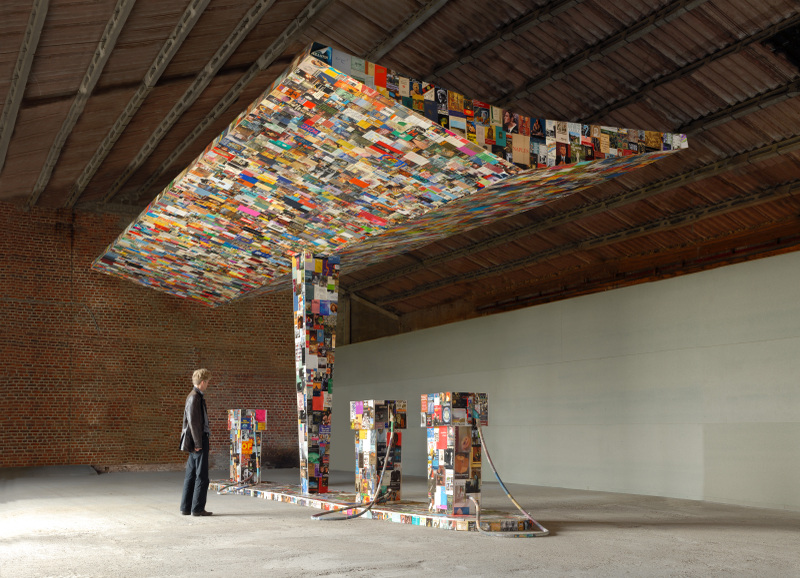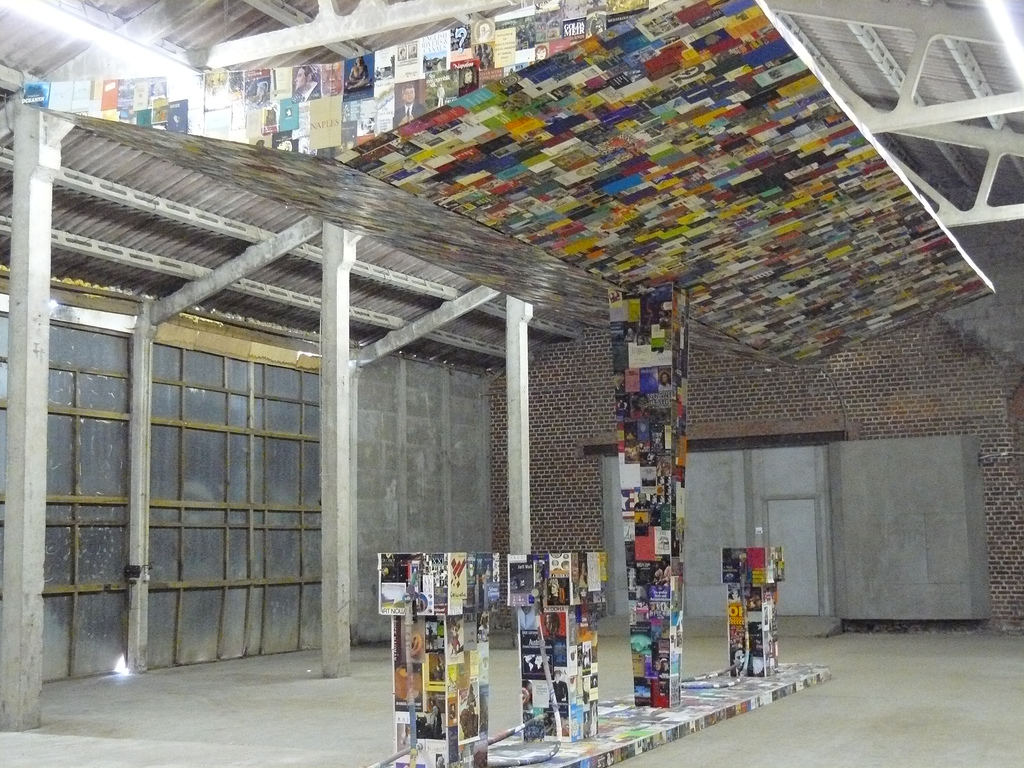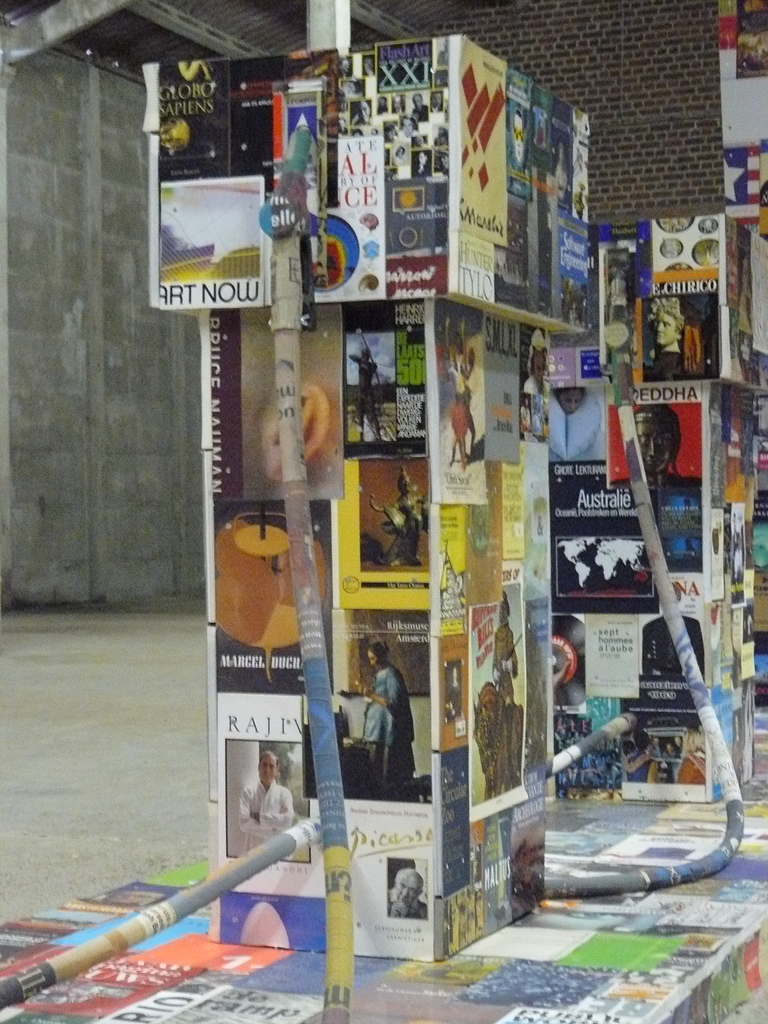 Image via Book Patrol
Image via Book Patrol
Books and gas stations may share about as much in common as smiling, demure Ivy League librarians and grease-smeared, tobacco-chewing, rip-off mechanics. On the one side, the cerebral, the edifying, the beneficent; on the other, the corporeal, the consumptive and, in today’s ever more environmentally sensitive climate, the foolish. Yet despite such oppositions, award-winning Dutch artist Job Koelewijn brought the two sets of ideas together in his incredible work “Sanctuary” (2007), which looms as a life-size gas station created from the covers of his own recycled books.
The blog Book Patrol wondered: “Is it a telling omen that in the future both gas stations and books will be extinct? A homage to the divergent sacredness of books and gasoline. Books and gasoline, two essential elements of Western civilization, joined to form a sort of surreal 22nd century filling station where one can go and pump the world’s creative output into their vehicle of choice, whether it be a computer, e-reader, iPod or quite possibly by then directly into our own bodies!”
 Image courtesy of Marianne W.
Image courtesy of Marianne W.
Book Patrol is an interesting read. It’s certainly true that the sacred stock of gasoline has fallen, as green technologies strive for renewable energy alternatives amid the concern of emissions and diminishing oil reserves. Yet while most are in favor of innovations like hybrid cars, the book enjoys greater cultural kudos than the gas-guzzling automobile, despite the forests felled to make our beloved paper
livres. “E-books can wait awhile,” we say. “We’re bug-eyed enough after a day chained to our monitors.”
That Koelewijn should choose to use books as the building materials for his gas station (with its connotations of conflagration) might remind the observer of Ray Bradbury’s dystopian novel
Fahrenheit 451, which depicts an American society in which reading has been banned and books are routinely burned. Yet the future to which Koelewijn alludes is less bleak by far if it is one where books are recycled rather than shamelessly destroyed — a practice long since carried out by charities and other groups.
 Image via Book Patrol
Image via Book Patrol
It may well be that with the advent of computers, a future of book recycling rather than book burning is closer to reality. In another of Koelewijn’s works, the similarly large-scale “Untitled” (2005), recycled books again provided the medium, with a bookshelf in the form of a lemniscate symbolizing the infinite nature of knowledge and the infinite power of books. This edifice adds wood to its construction, but like “Sanctuary” somehow bestows its collection of books with a vulnerability even as it exalts them. At the same time it expresses how art and words move in cycles.
“The way in which artworks endure, sometimes concealed, sometimes at eye level, close enough to touch, then forgotten for years, pushed away behind other books,” reads the introduction to one of Koelewijn’s exhibitions from 2006. “The words remain the same, and yet what is read changes from one age to the next.” Through these artworks, Koelewijn opens the way for infinite interpretations of his own work, eulogizing the possibly soon-to-be-extinct staple of culture that is the book while simultaneously recycling it — and so instilling it with the kind new life books are able to instill in us. The words “Fill ‘er up” never sounded so enlightened.
 Image courtesy of Marianne W.
Job Koelewijn’s conceptual yet highly visual and often tactile work has garnered him several prestigious prizes. He once held a residency at New York’s MoMA-associated PS1 art center and currently lives in Amsterdam.
Image courtesy of Marianne W.
Job Koelewijn’s conceptual yet highly visual and often tactile work has garnered him several prestigious prizes. He once held a residency at New York’s MoMA-associated PS1 art center and currently lives in Amsterdam.
Sources:
1,
2,
3
 Image via Book Patrol
Books and gas stations may share about as much in common as smiling, demure Ivy League librarians and grease-smeared, tobacco-chewing, rip-off mechanics. On the one side, the cerebral, the edifying, the beneficent; on the other, the corporeal, the consumptive and, in today’s ever more environmentally sensitive climate, the foolish. Yet despite such oppositions, award-winning Dutch artist Job Koelewijn brought the two sets of ideas together in his incredible work “Sanctuary” (2007), which looms as a life-size gas station created from the covers of his own recycled books.
The blog Book Patrol wondered: “Is it a telling omen that in the future both gas stations and books will be extinct? A homage to the divergent sacredness of books and gasoline. Books and gasoline, two essential elements of Western civilization, joined to form a sort of surreal 22nd century filling station where one can go and pump the world’s creative output into their vehicle of choice, whether it be a computer, e-reader, iPod or quite possibly by then directly into our own bodies!”
Image via Book Patrol
Books and gas stations may share about as much in common as smiling, demure Ivy League librarians and grease-smeared, tobacco-chewing, rip-off mechanics. On the one side, the cerebral, the edifying, the beneficent; on the other, the corporeal, the consumptive and, in today’s ever more environmentally sensitive climate, the foolish. Yet despite such oppositions, award-winning Dutch artist Job Koelewijn brought the two sets of ideas together in his incredible work “Sanctuary” (2007), which looms as a life-size gas station created from the covers of his own recycled books.
The blog Book Patrol wondered: “Is it a telling omen that in the future both gas stations and books will be extinct? A homage to the divergent sacredness of books and gasoline. Books and gasoline, two essential elements of Western civilization, joined to form a sort of surreal 22nd century filling station where one can go and pump the world’s creative output into their vehicle of choice, whether it be a computer, e-reader, iPod or quite possibly by then directly into our own bodies!”
 Image courtesy of Marianne W.
Book Patrol is an interesting read. It’s certainly true that the sacred stock of gasoline has fallen, as green technologies strive for renewable energy alternatives amid the concern of emissions and diminishing oil reserves. Yet while most are in favor of innovations like hybrid cars, the book enjoys greater cultural kudos than the gas-guzzling automobile, despite the forests felled to make our beloved paper livres. “E-books can wait awhile,” we say. “We’re bug-eyed enough after a day chained to our monitors.”
That Koelewijn should choose to use books as the building materials for his gas station (with its connotations of conflagration) might remind the observer of Ray Bradbury’s dystopian novel Fahrenheit 451, which depicts an American society in which reading has been banned and books are routinely burned. Yet the future to which Koelewijn alludes is less bleak by far if it is one where books are recycled rather than shamelessly destroyed — a practice long since carried out by charities and other groups.
Image courtesy of Marianne W.
Book Patrol is an interesting read. It’s certainly true that the sacred stock of gasoline has fallen, as green technologies strive for renewable energy alternatives amid the concern of emissions and diminishing oil reserves. Yet while most are in favor of innovations like hybrid cars, the book enjoys greater cultural kudos than the gas-guzzling automobile, despite the forests felled to make our beloved paper livres. “E-books can wait awhile,” we say. “We’re bug-eyed enough after a day chained to our monitors.”
That Koelewijn should choose to use books as the building materials for his gas station (with its connotations of conflagration) might remind the observer of Ray Bradbury’s dystopian novel Fahrenheit 451, which depicts an American society in which reading has been banned and books are routinely burned. Yet the future to which Koelewijn alludes is less bleak by far if it is one where books are recycled rather than shamelessly destroyed — a practice long since carried out by charities and other groups.
 Image via Book Patrol
It may well be that with the advent of computers, a future of book recycling rather than book burning is closer to reality. In another of Koelewijn’s works, the similarly large-scale “Untitled” (2005), recycled books again provided the medium, with a bookshelf in the form of a lemniscate symbolizing the infinite nature of knowledge and the infinite power of books. This edifice adds wood to its construction, but like “Sanctuary” somehow bestows its collection of books with a vulnerability even as it exalts them. At the same time it expresses how art and words move in cycles.
“The way in which artworks endure, sometimes concealed, sometimes at eye level, close enough to touch, then forgotten for years, pushed away behind other books,” reads the introduction to one of Koelewijn’s exhibitions from 2006. “The words remain the same, and yet what is read changes from one age to the next.” Through these artworks, Koelewijn opens the way for infinite interpretations of his own work, eulogizing the possibly soon-to-be-extinct staple of culture that is the book while simultaneously recycling it — and so instilling it with the kind new life books are able to instill in us. The words “Fill ‘er up” never sounded so enlightened.
Image via Book Patrol
It may well be that with the advent of computers, a future of book recycling rather than book burning is closer to reality. In another of Koelewijn’s works, the similarly large-scale “Untitled” (2005), recycled books again provided the medium, with a bookshelf in the form of a lemniscate symbolizing the infinite nature of knowledge and the infinite power of books. This edifice adds wood to its construction, but like “Sanctuary” somehow bestows its collection of books with a vulnerability even as it exalts them. At the same time it expresses how art and words move in cycles.
“The way in which artworks endure, sometimes concealed, sometimes at eye level, close enough to touch, then forgotten for years, pushed away behind other books,” reads the introduction to one of Koelewijn’s exhibitions from 2006. “The words remain the same, and yet what is read changes from one age to the next.” Through these artworks, Koelewijn opens the way for infinite interpretations of his own work, eulogizing the possibly soon-to-be-extinct staple of culture that is the book while simultaneously recycling it — and so instilling it with the kind new life books are able to instill in us. The words “Fill ‘er up” never sounded so enlightened.
 Image courtesy of Marianne W.
Job Koelewijn’s conceptual yet highly visual and often tactile work has garnered him several prestigious prizes. He once held a residency at New York’s MoMA-associated PS1 art center and currently lives in Amsterdam.
Sources: 1, 2, 3
Image courtesy of Marianne W.
Job Koelewijn’s conceptual yet highly visual and often tactile work has garnered him several prestigious prizes. He once held a residency at New York’s MoMA-associated PS1 art center and currently lives in Amsterdam.
Sources: 1, 2, 3